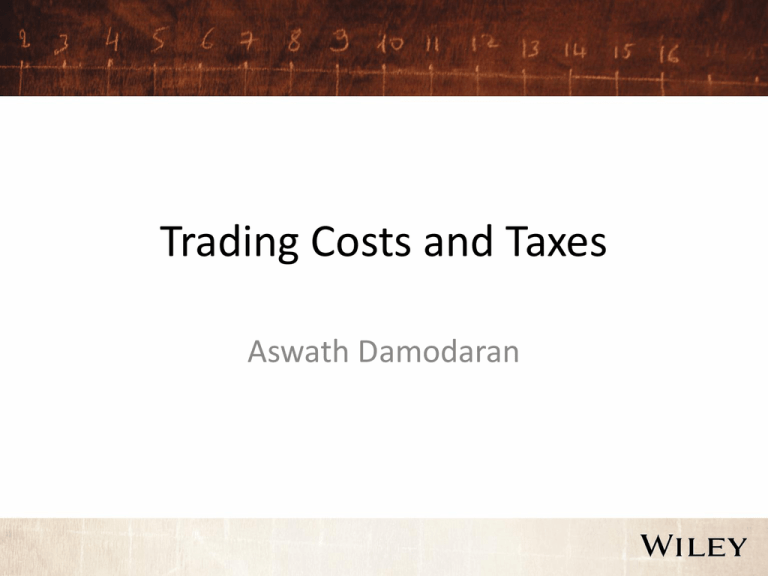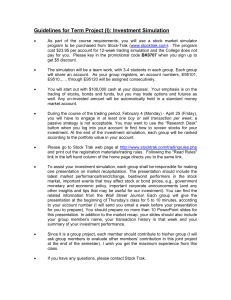Session 5- Trading Costs - NYU Stern School of Business
advertisement

Trading Costs and Taxes Aswath Damodaran The Components of Trading Costs 1. 2. 3. 4. Brokerage Cost: This is the most explicit of the costs that any investor pays but it is usually the smallest component. Bid-Ask Spread: The spread between the price at which you can buy an asset (the dealer’s ask price) and the price at which you can sell the same asset at the same point in time (the dealer’s bid price). Price Impact: The price impact that an investor can create by trading on an asset, pushing the price up when buying the asset and pushing it down while selling. Opportunity Cost: There is the opportunity cost associated with waiting to trade. While being a patient trader may reduce the previous two components of trading cost, the waiting can cost profits both on trades that are made and in terms of trades that would have been profitable if made instantaneously but which became unprofitable as a result of the waiting. Simple Evidence of a Trading Cost Drag • Active money managers trade because they believe that there is profit in trading, and the return to any active money manager has three ingredients to it: – Return on active money manager = Expected ReturnRisk + Return from active trading - Trading costs • The average active money manager makes about 1% less than the market. If we assume that the return to active trading is zero across all active money managers, the trading costs have to be roughly 1%. If we believe that there is a payoff to active trading, the trading costs must be much higher. Many a slip… The Value Line experience.. Figure 5.1: Value Line - Paper Portfolio versus Real Fund $2,500.00 Value of $100 invested in 1978 $2,000.00 $1,500.00 Paper Portfolio Real Fund $1,000.00 $500.00 $0.00 1978 1979 1980 1981 1982 1983 1984 1985 1986 1987 1988 1989 1990 1991 Year Why is there a bid-ask spread? • In most markets, there is a dealer or market maker who sets the bid-ask spread, and there are three types of costs that the dealer faces that the spread is designed to cover. – The first is the risk cost of holding inventory; – the second is the cost of processing orders and – the final cost is the cost of trading with more informed investors. • The spread has to be large enough to cover these costs and yield a reasonable profit to the market maker on his or her investment in the profession. Factors determining the bid-ask spread 1. 2. 3. 4. 5. 6. Liquidity: More liquid stocks have lower bid-ask spreads. Ownership structure: Stocks with increases in institutional activity report higher bid-ask spreads (perhaps because institutional investors tend to be more likely to be informed?) Riskiness: Riskier stocks tend to have higher bid-ask spreads Price level: The spread as a percent of the price increases as price levels decrease. Information transparency & corporate governance: Bid-ask spreads tend to increase as information becomes more opaque (less transparent) and as corporate governance gets weaker. Market microstructure: The exchange on which an asset is traded can affect bid-ask spreads as does the mode of trading: electronic versus floor trading, for instance. Bid Ask Spread for US stocks - By Market Cap More on variation in spreads across US stocks… • Price level: Lower priced stocks have substantially higher spreads (as a percent of stock price) than higher priced stocks. In studies of bid ask spreads around stock splits, the spread as a percent of the stock price just before and after stock splits, the spread cost (as a percent of the stock price) increases significantly after stock splits. • Trading volume: A study found that the stocks in the top 20% in terms of trading volume had an average spread of only 0.62% of the price while the stocks in the bottom 20% had a spread of 2.06%. • Ownership structure: As insider holdings increase, as a percent of total stock outstanding, bid ask spreads increase, reflecting lower liquidity (since insiders don’t trade their holdings as frequently) and a fear that insiders may know more about the company than other investors (information asymmetry). Spreads in other equity markets Variation in equity spreads over time… Effects of crisis – 51 large caps Role of Spread in Investment Strategies • Strategies that involve investing in small-cap stocks or lowprices stocks will be affected disproportionately by the costs created by bid-ask spreads. • As an example, consider the strategy of buying “losers”. DeBondt and Thaler(1985) present evidence that a strategy of buying the stocks which have the most negative returns over the previous year and holding for a five-year period earns significant excess returns. A follow-up study, however, noted that many of these “losers” were low-priced stocks, and that putting in a constraint that the prices be greater than $10 on this strategy resulted in a significant drop in the excess returns. – Does the Stock Market Overreact? by F.M DeBondt and R. Thaler in Journal of Finance (July 1985) Why is there a price impact? • The first is that markets are not completely liquid. A large trade can create an imbalance between buy and sell orders, and the only way in which this imbalance can be resolved is with a price change. This price change, that arises from lack of liquidity, will generally be temporary and will be reversed as liquidity returns to the market. • The second reason for the price impact is informational. A large trade attracts the attention of other investors in that asset market because if might be motivated by new information that the trader possesses. This price effect will generally not be temporary, especially when we look at a large number of stocks where such large trades are made. While investors are likely to be wrong a fair proportion of the time on the informational value of large block trades, there is reason to believe that they will be right almost as often. How large is the price impact? Evidence from Studies of Block Trades Total Trading Cost as a Function of Market Cap and Trade Size Sector Smallest 2 3 4 5 6 7 8 Largest 5 25 17.30% 27.30% 8.90% 12.00% 5.00% 7.60% 4.30% 5.80% 2.80% 3.90% 1.80% 2.10% 1.90% 2.00% 1.90% 1.90% 1.10% 1.20% Dollar Value of Block ($ thoustands) 250 500 1000 2500 5000 10000 43.80% 23.80% 33.40% 18.80% 25.90% 30.00% 9.60% 16.90% 25.40% 31.50% 5.90% 8.10% 11.50% 15.70% 25.70% 3.20% 4.40% 5.60% 7.90% 11.00% 16.20% 3.10% 4.00% 5.60% 7.70% 10.40% 14.30% 2.70% 3.30% 4.60% 6.20% 8.90% 13.60% 1.30% 1.71% 2.10% 2.80% 4.10% 5.90% 20000 20.00% 18.10% 8.00% Impact on Investment Strategy • The fact that assets which have high bid-ask spreads also tend to be assets where trading can have a significant price impact makes it even more critical that we examine investment strategies that focus disproportionately in these assets with skepticism. • Since you can reduce the price impact of trades by breaking them up into smaller trades, the price impact cost is likely to be greatest for investment strategies that require instantaneous trading. • The price impact effect also will come into play when a small portfolio manager, hitherto successful with an investment strategy, tries to scale up the strategy The Cost of Waiting • If there was no cost to waiting, even a large investor could break up trades into small lots and buy or sell large quantities without affecting the price or the spread significantly. • There is, however, a cost to waiting. In particular, the price of an asset that an investor wants to buy because he or she believes that it is undervalued may rise while the investor waits to trade, and this, in turn, can lead to one of two consequences. – One is that the investor does eventually buy, but at a much higher price, reducing expected profits from the investment. – The other is that the price rises so much that the asset is no longer under valued and the investor does not trade at all. A similar calculus applies when an investor wants to sell an asset that he or she thinks is overvalued. Determinants of the Cost of Waiting • Is the valuation assessment based upon private information or is based upon public information? Private information tends to have a short shelf life in financial markets, and the risks of sitting on private information are much greater than the risks of waiting when the valuation assessment is based upon public information. • How active is the market for information? The risks of waiting, when one has valuable information, is much greater in markets where there are other investors actively searching for the same information. • How long term or short term is the strategy? Short term strategies will be affected more by the cost of waiting than long term strategies. • Is the investment strategy a “contrarian” or “momentum” strategy? In a contrarian strategy, where investors are investing against the prevailing tide, the cost of waiting is likely to be smaller than in a momentum strategy. Trading costs on real assets • The smallest transactions costs are associated with commodities – gold, silver or diamonds – since they tend to come in standardized units. • With residential real estate, the commission that you have to pay a real estate broker or salesperson can be 5-6% of the value of the asset. With commercial real estate, it may be smaller for larger transactions. • With fine art or collectibles, the commissions become even higher. • The costs tend to be higher because: – There are far fewer intermediaries in real asset businesses than there are in the stock or bond markets – The products are not standardized. In other words, one Picasso can be very different from another, and you often need the help of experts to judge value and arrange transactions. This adds to the cost in the process. Why taxes matter? The Tax Effect and Dividend Yields Mutual Funds: Tax Effect and Turnover Ratios How to manage taxes… • Keep trading to a minimum: The more you trade, the higher the tax liability you will face as an investor. • Factor in taxes when buying: When investing, take into account the expected tax drag on returns. Thus, if dividends are taxed at a rate higher than capital gains, you will pay more in taxes. If you don’t need the cash from dividends, you will do better investing in stocks that deliver more price appreciation. • Factor in taxes when selling: When trading, consider the tax effects of your trades. Match losing stock sales with capital gains. • Don’t invest just to avoid taxes: Investments that are structured primarily to avoid taxes are not only often bad investments but they are more likely to be challenged by tax authorities.





